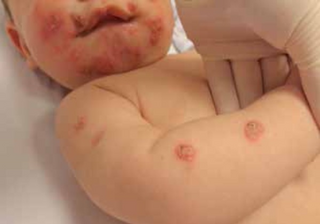Halogenoderma
| Halogenoderma | |
|---|---|
| Top: Iododerma Bottom: Bromoderma | |
| Specialty | Dermatology |
| Types | Iododerma, Bromoderma[1] |
| Frequency | Rare[1] |
Halogenodermas are skin eruptions that present as large bumps filled with pus that may ulcerate and weep, usually on the face and upper body.[2] It occurs after longterm exposure to high levels of halogen-containing medicines or substances.[2][3] Types include iododerma and bromoderma.[1]
This may last several weeks after drug use is discontinued. This is because of the slow elimination rate of iodides and bromides.[4] Fluoroderma is a particular type of halogenoderma which is caused by fluoride. Fluoride is present in oral hygiene products such as toothpastes and mouth washes, hence this type of acne is seen mostly around the mouth and jawline. Acute fluoroderma has been observed in patients exposed to anaesthetics containing fluoride such as sevoflurane.[5]
It can appear similar to a deep fungal infection.[2]
The term is sometimes used interchangeably with Halogen acne and has also been called halogen rosacea.[6]
Cause
It is caused by high levels of halogen in the body, usually from medicines that contain them.[1]
Treatment
Medications given for halogenoderma may include topical and systemic corticosteroids, diuretics, and cyclosporine.[4]
See also
References
- ↑ 1.0 1.1 1.2 1.3 Dyall-Smith, Welwyn (2009). "Halogenodermas | DermNet NZ". dermnetnz.org. Archived from the original on 12 August 2021. Retrieved 16 April 2022.
- ↑ 2.0 2.1 2.2 Braun-Falco, Otto; Plewig, Gerd; Wolff, Helmut Heinrich; Burgdorf, Walter H. C. (2000). "28. Diseases of the sebaceous glands". Dermatology (2nd ed.). Springer. p. 1071. ISBN 978-3-642-97933-0. Archived from the original on 2022-04-18. Retrieved 2022-04-17.
- ↑ James, William D.; Elston, Dirk; Treat, James R.; Rosenbach, Misha A.; Neuhaus, Isaac (2020). "6. Contact dermatitis and drug eruption". Andrews' Diseases of the Skin: Clinical Dermatology (13th ed.). Edinburgh: Elsevier. p. 136. ISBN 978-0-323-54753-6. Archived from the original on 2022-04-17. Retrieved 2022-04-16.
- ↑ 4.0 4.1 Rapini, Ronald P.; Bolognia, Jean L.; Jorizzo, Joseph L. (2007). Dermatology: 2-Volume Set. St. Louis: Mosby. p. 310. ISBN 978-1-4160-2999-1.
- ↑ Perbet, S.; Salavert, M.; Amarger, S.; Constantin, J.-M.; D'Incan, M.; Bazin, J.-E. (1 July 2011). "Fluoroderma after exposure to sevoflurane". British Journal of Anaesthesia. 107 (1): 106–107. doi:10.1093/bja/aer180. PMID 21685121. Archived from the original on 14 June 2021. Retrieved 24 December 2020 – via bja.oxfordjournals.org.
- ↑ Plewig, Gerd; Melnik, Bodo; Chen, WenChieh (2019). "14.14. Halogen rosacea". Plewig and Kligman ́s Acne and Rosacea (4th ed.). Switzerland: Springer. p. 522. ISBN 978-3-319-49273-5.
External links
| Classification |
|---|

